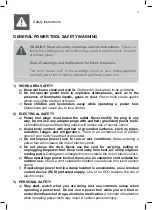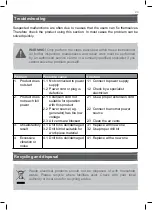
u)
Switch off the power tool immediately when the drill bit jams.
Be prepared
for high reaction torque that can cause kickback. The drill bit jams when: the
power tool is subject to overload or it becomes wedged in the workpiece. Switch
the power tool off. Loosen the drill bit.
v) Switch the product off immediately if you are disturbed while working by other
people entering the working area. Always let the product come to complete stop
before putting it down.
w) Do not overwork yourself. Take regular breaks to ensure you can concentrate
on the work and have full control over the product.
x) Always keep the power cord behind the power tool.
The following information applies to professional users only but is good practice for all
users:
ADDITIONAL SAFETY WARNINGS FOR CONSTRUCTION DUST
The updated Control of Substances Hazardous to Health Regulations 1st October
2012 now also targets to reduce the risks associated with silica, wood and gypsum
dusts.
Construction workers are one of the at-risk groups within this because of the dust that
they breathe: silica dust is not just a nuisance; it is a real risk to your lungs!
Silica is a natural mineral present in large amounts in things like sand, sandstone and
granite. It is also commonly found in many construction materials such as concrete and
mortar. The silica is broken into very fine dust (also known as Respirable Crystalline
Silica or RCS) during many common tasks such as cutting, drilling and grinding.
Breathing in very fine particles of crystalline silica can lead to the development of:
• lung cancer
• Silicosis
• Chronic obstructive pulmonary disease (COPD).
And breathing in fine particles of wood dust can lead to the development of Asthma.
The risk of lung disease is linked to people who regularly breathe construction dust
over a period of time, not on the odd occasion.
To protect the lung, the COSHH Regulations sets a limit on the amount of these dusts
that you can breathe (called a Workplace Exposure Limit or WEL) when averaged over
a normal working day. These limits are not a large amount of dust: when compared to
a penny it is tiny – like a small pinch of salt:
This limit is the legal maximum; the most you can breathe after the right controls have
been used.
How to reduce the amount of dust?
1. Reduce the amount of cutting by using the best sizes of building products.
2. Use a less powerful tool e.g. a block cutter instead of angle grinder.
3. Using a different method of work altogether – e.g. using a nail gun to direct fasten
cable trays instead of drilling holes first.
Please always work with approved safety equipment, such as those dust masks that
specially designed to filter out microscopic particles and use the dust extraction facility
at all time.
For more information please see the HSE website:
http://www.hse.gov.uk/construction or http://www.hse.gov.uk/pubns/cis69.pdf
9










































